Commercial Heating Equipment Market Research, 2032
The global Commercial Heating Equipment Market size was valued at $15.1 billion in 2018, and is projected to reach $25.6 billion by 2032, growing at a CAGR of 5.2% from 2023 to 2032. Commercial Industrial heating equipment is used for heating up large establishment spaces that are commercial in nature and may include offices, factories, shops, showrooms, godowns, restaurants & hotels etc. Heating equipment associated with commercial use are diverse and they include furnaces, boilers, heat pumps, and infrared heatersamongst others. Furnaces commonly use fuel for producing the heat while boilers utilize water or steam for disbursal of warmth. Heaters have different kinds Heat pumps that move heat from one area to another and Infrared heaters that radiate heat. The use of commercial heating equipment is valuable for maintaining indoor environment suitable for optimum performance by workforce, protecting industrial products from degradation, and meeting safety requirements. Therefore, there are significant guidelines in choosing and working on these systems, the most crucial ones including installation, maintenance, and energy aspects.
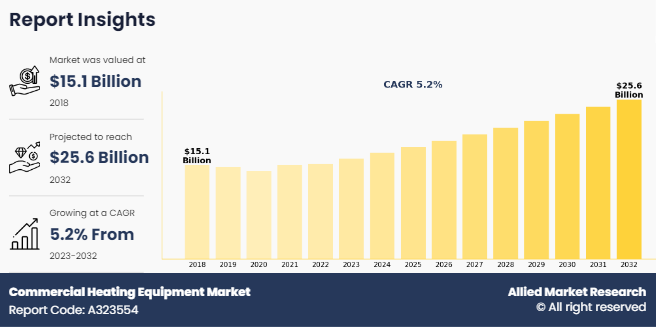
Commercial Heating Equipment Market Overview
Heating equipment for commercial use is considered highly significant in responding to the increasing needs for efficient and reliable heating equipment for different industries. Among the essential installations that guarantee comfortable and healthy conditions indoors especially in offices, published and electronic shops, hospitals and schools, heating equipment is crucial given the ever increasing demand for climate control in form of heating. As commercial buildings come up especially in urban centers, and with increased congestion, there is a demand to ensure that heating systems are put in place to meet the most efficient working environment or customer comfort as the case may be. Furthermore, due to the current initiatives of organizations to enhance the efficiency and power use in their operations, proper and updated commercial heating systems must be installed.
The modern-commercial heating systems possess greater levels of technology and design that focuses on energy conservation. It uses features such as high efficiency burners, programmable controls, and heat recovery circuits to ensure optimal energy is used. Attaining near-zero waste and high-heat release, these systems contribute to less emissions and lower costs for the industries. Besides, they provide steady and accurate heat settings as well as heating requirements in various sectors and establishments. This paper examines the positive impacts of energy efficient heating solutions on the environment whereby the implementation of such techniques has the ability to lessen the emission of greenhouse gases and further makes the case on how such positive changes profit the business in terms of cost efficiency and sustainability in the long run.
Key Takeaways of Industrial Heating Equipment Market Report:
Based on product type, the heat pumps segment held the largest commercial heating equipment market share in 2018. The heat pumps segment is anticipated to grow at the fastest CAGR during the forecast period.
Based on fuel type, the electric segment dominated the commercial heating equipment market size in terms of revenue in 2018. The electric segment is anticipated to grow at the fastest CAGR during the forecast period.
Based on end-user industry, the restaurants and hotels segment held the largest share in the commercial heating equipment industry in 2018 and is anticipated to grow at the fastest CAGR during the forecast period.
Region-wise, Asia-Paicific held the largest market share in 2018. Asia-Pacific is expected to witness the highest CAGR during the forecast period.
Commercial Heating Equipment Market Dynamics
The commercial heating equipment market growth is propelled by several key drivers such as the rising demand for energy-efficient systems, as businesses strive to lower operational costs and adhere to strict environmental regulations. More advanced devices like smart home controls, heating, and building automation improves the control, temperatures, and effective utilization of thermal energy which in turn improves the commercial comfort. There is high market demand for heat pumps and furnaces due to rising construction of commercial buildings, hotels and restaurants since any new establishment requires eficient heating systems to meet its needs. One of the biggest challenges that may hinder the implementation of new heating systems in businesses is the relatively high initial costs of adopting sophisticated systems, especially for small and medium scale businesses. However, the high costs and difficulties in installing and managing some of the high-technology applications may hamper their uptake. It also has negative effects on market growth by diminishing the construction rate and business investments on new structures during economic downturns.
However, existing commercial heating equipment market conditions such as unpredictable energy cost and availability of other kinds of heating methods may influence the market conditions. There are a number of opportunities that one needs to look at in the market regarding commercial heating equipment as follows. The inclination towards use of green and renewable energy presents the opportunity for eco-friendly heating in manufacturers.
Moreover, various forms of heating that may add versatility to a given space have been on the rise especially for the hospitality industry, and such include portable heaters as well as the infrared heaters. As for the sectors, improvements in heating systems and shifts in the stylistic trends in commerce and offices also entail the expansion potential since companies search for quick and aesthetically acceptable heating.
Segment Overview
The commercial heating equipment market is segmented into product type, fuel type and end user.
By Product Type
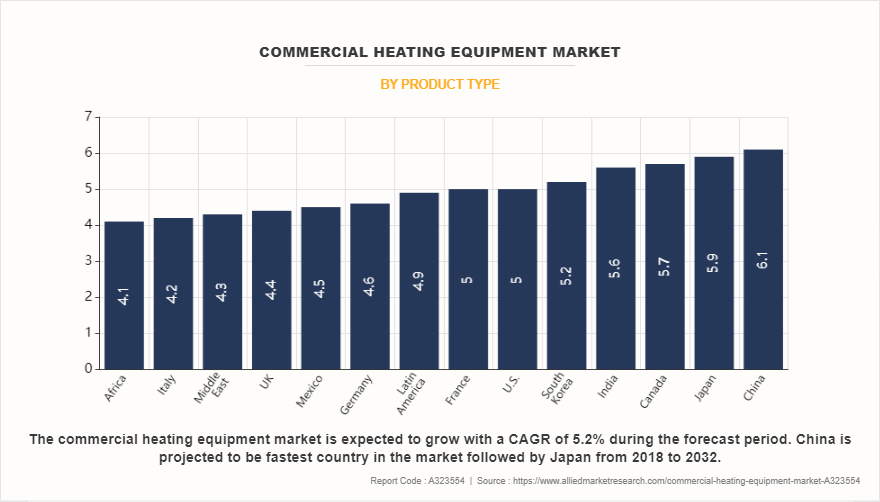
On the basis of product type, the market is bifurcated into heat pumps, furnaces, and boilers. In 2018, the heat pumps segment dominated the market, and it is expected to acquire a major market share by 2032.
By Fuel Type
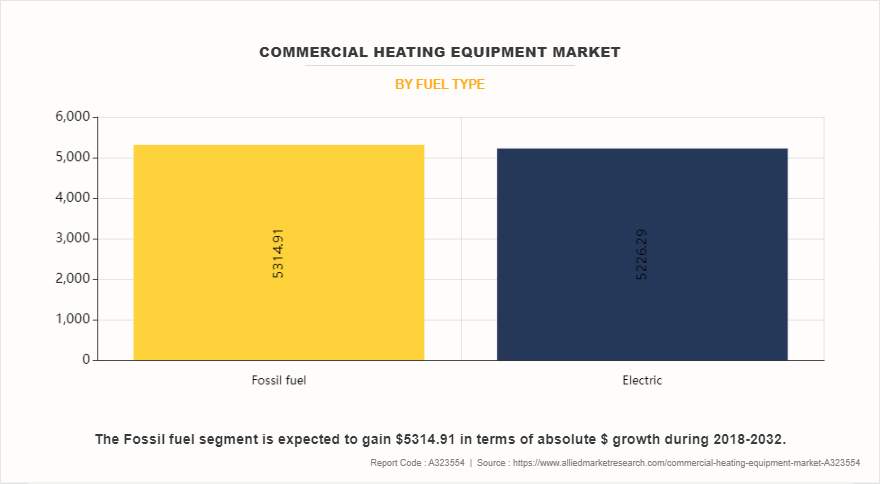
On the basis of fuel type, the market is bifurcated into fossil fuel, and electric. In 2018, the electric segment dominated the market, and itis expected to acquire a major market share by 2032.
By End User
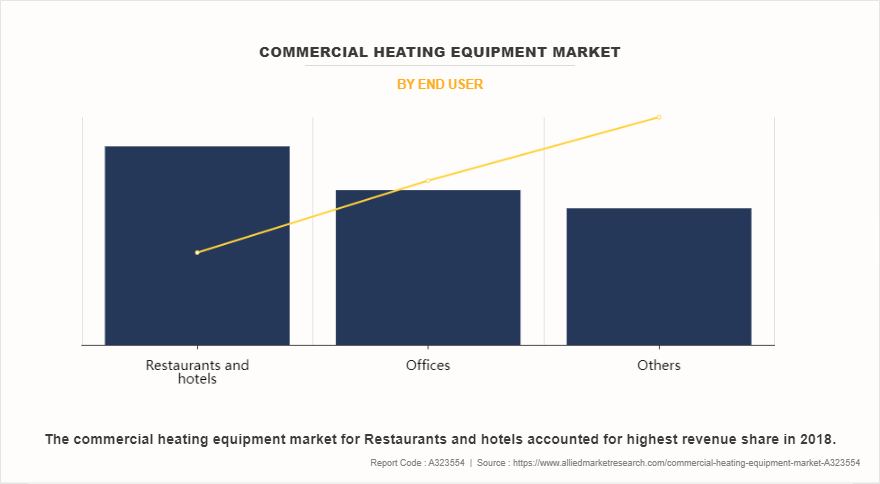
On the basis of end user, the market is bifurcated into offices, restaurants and hotels, and others. In 2018, the restaurants and hotels segment dominated the market, and itis expected to acquire a major market share by 2032.
By Region
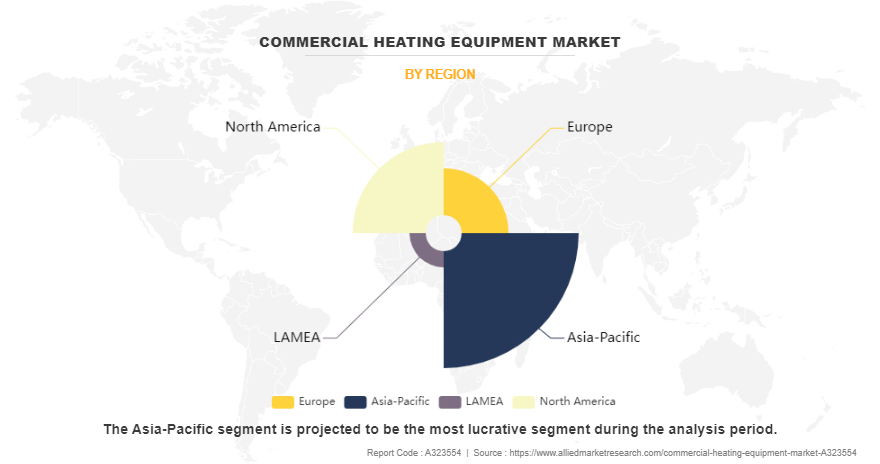
On the basis of region, the global commercial heating equipment market is analyzed across North America (the U.S., Canada, and Mexico), Europe (Germany, UK, France, Spain, and Rest of Europe), Asia-Pacific (China, Japan, India, South Korea, and rest of Asia-Pacific), and LAMEA (Latin America, Middle East, and Africa). In 2018, Asia-Pacific held the largest market share in the commercial heating equipment industry owing to strong manufacturing activities, economic development, increase in production activities, and rise in foreign investment act as the major drivers of the LAMEA commercial heating equipment market.
Country Analysis
In North America, the commercial heating equipment market is driven by stringent energy efficiency regulations and a high demand for advanced HVAC systems. The U.S. leads the market with significant investments in commercial construction and renovation projects. Canada's cold climate further propels the need for efficient heating solutions, enhancing market growth across the region.
Europe's commercial heating equipment market benefits from strict environmental policies and a strong emphasis on sustainability. Germany and the UK are key players, focusing on energy-efficient and renewable heating technologies. The European Union's commitment to reducing carbon emissions and increasing energy efficiency in commercial buildings drives the adoption of advanced heating systems across the region.
In the Asia-Pacific region, rapid urbanization and industrialization fuel the commercial heating equipment market. China and India are the largest markets, driven by extensive commercial construction activities and rising energy demands. Increasing awareness of energy conservation and government incentives for green buildings boost the adoption of advanced heating technologies in this diverse and fast-growing region.
The LAMEA (Latin America, Middle East, and Africa) commercial heating equipment market experiences moderate growth due to varying climatic conditions and economic factors. Brazil and the UAE are prominent markets, with growing investments in commercial infrastructure. Increasing focus on energy efficiency and sustainable development in these regions supports the gradual adoption of advanced heating solutions.
Top Impacting Factors
The commercial heating equipment market outlook is expected to witness notable growth owing to rapid urbanization globally, increasing awareness of environmental issues and growth of the commercial sector. Moreover, the incorporation of IOT devices and smart technologies into heating systems and updating heating systems with modern, and energy-efficient alternatives are expected to provide lucrative opportunities for the growth of the market during the forecast period. On the contrary, high initial costs and implementation of stringent government regulations toward environmental pollution limit the growth of the commercial heating equipment market.
Key Developments/ Strategies
According to the latest commercial heating equipment market overview, Mitsubishi Electric Corporation, Uponor Corporation, Johnson Controls, Robert Bosch GmbH., Carrier, FUJITSU GENERAL, Danfoss, DAIKIN INDUSTRIES, Ltd., Panasonic Corporation (Panasonic Holdings Corporation) and Lennox International Inc are the top players in the commercial heating equipment market. Top market players have adopted a product launch, expansion, acquisitions, agreements, investment, contract, and product development strategies to expand their foothold in the commercial heating equipment market forecast.
- January 2024 - Carrier launched u-Series portfolio, a heat recovery unit, debuted at the AHR Expo hosted in Chicago. The u-Series lineup is a globally recognized, next generation, three-phase, full line of VRF equipment for commercial and large residential needs.
- January 2024 - Daikin acquired the British service company Robert Heath Heating Ltd. The deal that was signed is anticipated to strengthen Daikin's residential heating service network in the UK. The acquisition supports Daikin's plans to become a total solutions provider in the heating, ventilation, air conditioning, and refrigeration (HVAC-R) market.
- April 2024 - Mitsubishi Electric Corporation developed a new airflow-control technology that both visualizes and analyzes airflow from air-conditioning systems and temperature distribution for optimized room-wide comfort. The technology predicts airflows and temperatures, which vary according to the room shape and air-conditioning system layout, to determine how to minimize uneven temperatures and discomfort due to excessively strong airflow
Key Benefits For Stakeholders
- This report provides a quantitative analysis of the market segments, current trends, estimations, and dynamics of the commercial heating equipment market analysis from 2018 to 2032 to identify the prevailing commercial heating equipment market opportunities.
- The market research is offered along with information related to key drivers, restraints, and opportunities.
- Porter's five forces analysis highlights the potency of buyers and suppliers to enable stakeholders make profit-oriented business decisions and strengthen their supplier-buyer network.
- In-depth analysis of the commercial heating equipment market segmentation assists to determine the prevailing market opportunities.
- Major countries in each region are mapped according to their revenue contribution to the global market.
- Market player positioning facilitates benchmarking and provides a clear understanding of the present position of the commercial heating equipment market players.
- The report includes the analysis of the regional as well as global commercial heating equipment market trends, key players, market segments, application areas, and market growth strategies.
Commercial Heating Equipment Market Report Highlights
| Aspects | Details |
| Market Size By 2032 | USD 25.6 billion |
| Growth Rate | CAGR of 5.2% |
| Forecast period | 2018 - 2032 |
| Report Pages | 275 |
| By Product Type |
|
| By Fuel Type |
|
| By End User |
|
| By Region |
|
| Key Market Players | Mitsubishi Electric Corporation, Robert Bosch GmbH., DAIKIN INDUSTRIES, Ltd.,, Rheem Manufacturing Company., Panasonic Corporation (Panasonic Holdings Corporation), Uponor Corporation, FUJITSU GENERAL., Johnson Controls, Lennox International Inc., Carrier |
Analyst Review
According to the insights of CXOs of leading companies, the commercial heating equipment market is mainly driven by factors such as increasing demand for energy-efficient solutions, advancements in technology leading to enhanced product offerings, stringent regulations promoting sustainability, and growing industrialization across emerging economies.
However, implementation of stringent government regulations toward environmental pollution acts as restraint to the industrial heating equipment market growth. On the contrary, increase in popularity of geothermal heat pump technology has led to adoption of these heat pumps in manufacturing processes and will be a major opportunity for the industrial heating equipment market during the forecast period.
Major companies in the market have adopted strategies such as product launch and acquisition to offer better products and services to customers in the industrial heating equipment market. For instance, in November 2023, Johnson Controls received a $33 million grant from the U.S. Department of Energy's (DOE) Office of Manufacturing and Energy Supply Chains to help increase domestic production of electric heat pumps by expanding three U.S.-based manufacturing sites. The new plants produce an estimated 200,000 residential, commercial, and industrial heat pumps combined—a production increase of 200%.
Upcoming trends in the global commercial heating equipment market include the adoption of smart, energy-efficient systems and renewable energy-based heating solutions.
The leading application of the commercial heating equipment market is in heating commercial buildings, including offices, hotels, and restaurants.
Asia-Pacific is the largest regional market for Commercial Heating Equipment.
The estimated industry size of Commercial Heating Equipment was $15,058.4 in 2018.
Mitsubishi Electric Corporation, Uponor Corporation, Johnson Controls, Robert Bosch GmbH., Carrier, FUJITSU GENERAL, Danfoss, DAIKIN INDUSTRIES, Ltd., Panasonic Corporation (Panasonic Holdings Corporation) and Lennox International Inc
Loading Table Of Content...
Loading Research Methodology...



